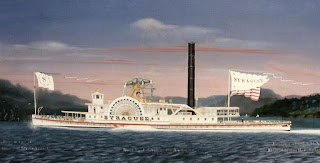The great ST. JOHN idle on the Hudson River c.1864
The ST. JOHN and DREW, along with the DEAN RICHMOND, were the People's Line response to the river's ever-increasing traffic of the 1860s. The Troy-based steamboat Line
commissioned John Englis Shipyard in Brooklyn, New York to build a vessel that surpassed any contemporary steamboat of its time. The word "floating palace" became a new meaning for the massive sidewheeler ST. JOHN.
She was launched in 1863 to serve as a nightboat between New York and Albany. She was 393 feet in length, 51 feet in beam with a 10.2 feet depth of hold. Made of wood, her gross tonnage was 2645. Her engine was inherited from the large nightboat NEW WORLD, which sunk when her gallows frame collapsed and sent her walking beam crashing into her interior in 1859.
Currier and Ives print of nightboat ST. JOHN c. 19th century
Saratoga, Lake George, Lake Champlain and the Adirondacks were visited by thousands buring the decade of the 1860s. To accommodate these visitors and get them to these northern points, ST. JOHN set the course in both design and fashion for nightboats in 1863. The United States was at war with itself, but inspite of this civil unrest, citizens and foreigners continued to travel the picturesque Hudson River to enjoy those regions north of the Capital City.
The reputation of ST.JOHN was so great that newspapers heralded her beauty and size, prompting international visitors to board and admire her. The sidewheeler featured a high dome deck with staterooms on galleries. The grand staircase was carved of St. Domingo mahogany, inlaid with white holly, and double inlaid stars featured the newel posts.
Scale nightboat model of ST. JOHN exhibiting port profile. Scratchbuilt in three
wood types, it is scaled at 1/8" = 1' with an overall length of 48" inches.
ST. JOHN's first river tragedy occurred during her first year of service. On the evening of October 29, 1863 when only a few miles below Albany, New York, one of the boilers exploded with the loss of fifteen people. Her second and final disaster came when she was laid up at her winter quarters in New York City. At the foot of Canal Street, on January 24, 1885, she caught fire and was destroyed.
ST. JOHN ran on the Hudson River for 21 years, attracting a large following during her years of service. Like most notable vessels of her time, she was captured in photos, drawings, prints and paintings by some of the most prolific maritime artists of the period. In contemporary times, no true model ever existed on this famous steamboat which prompted me to research, build, and bring this image into public view as a scale model.
ST. JOHN's portside overview appearance of 1864 - Author's build
The author's plan profile of ST. JOHN's paddlebox design as it appeared
in 1863.
Although the paddlebox was a flat surface, the designers of the period produced an astonishing effect by introducing 'lines of perspective'. This particular technique gave the appearance of looking into a long colonaded room extending through the inside of the boat. The effect of perspective was heightened by painting in a tile floor of contrasting shades. Deep inside the composition a gate built up of lattice work gave out onto a painted landscape which was the envy of many interior designers of that day. Two years later the DEAN RICHMOND appeared on the river with similiar paddlebox treatment which gave a startling impression to passengers on passing boats.
This was the era of size and beauty, the 1860s. ST. JOHN was a vision for bold visionaries who took the idea from the drafting table to the shipyard -making this sidewheeler a prominent reality and one of the great legends of her day.
Starboard Profile of Hudson River nightboat ST. JOHN - Rex Stewart
For more information about commissioning a fine quality Hudson River or Northeast steamboat model email: Caseships@yahoo.com or call 1-774-757-7137. You may also visit http://www.rexstewartoriginals.com.














































